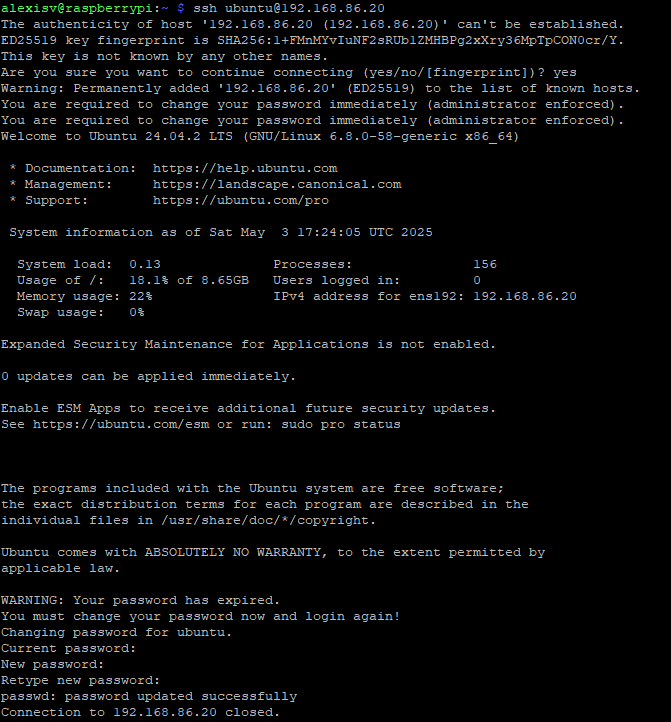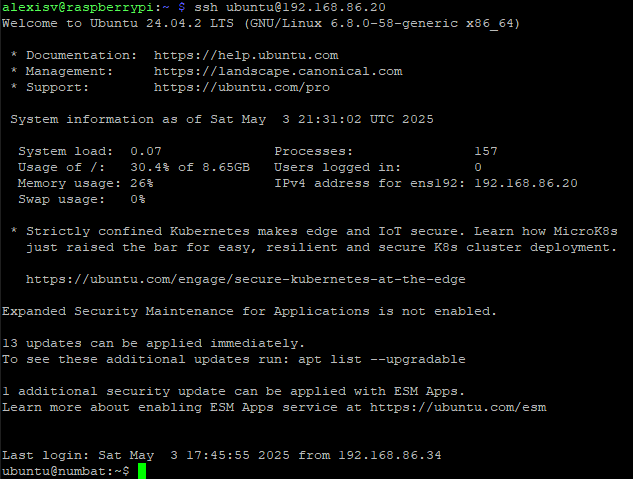Noble Numbat
Noble Numbat. Interesting name. That’s the codename of the latest major version of the Ubuntu Server that has Long Term Support (LTS). That is Ubuntu Server 24.04 LTS (Noble Numbat). I gather that the first word of the codename will be used to call the release, and so I’ll call this “Noble”.
In this post, I will create a “jumpbox” VM using the Noble cloud image. I will use this jumpbox to run “tanzu” cli commands, primarily to create and manage TKGM management and workload clusters.
Let’s get going.
Download the Ubuntu image
Ubuntu images can be dowloaded from the Ubuntu Cloud Images site. From that page, I selected the “noble” folder, and then selected the latest daily build date, which at this time was “20250430”. I found the file with the description of “VMware/Virtualbox OVA”. I downloaded that file. It was 555MB in size. The file name was noble-server-cloudimg-amd64.ova.
Deploy the image to vSphere
- In vCenter, right-click on the cluster object and then select “Deploy OVF Template”.
- In the “Select an OVF template” tab, select “Local file” and then upload the downloaded OVA file. Then, click “Next”.
- In the “Select a name and folder” tab, leave the VM name as it is, which is
ubuntu-noble-24.04-cloudimg. Select the folderpcf_vmsas the location. Then, click “Next” - In the “Select a compute resource” tab, select the cluster and then click “Next”.
- In the “Review details” tab, just click “Next”.
- In the “Select storage” tab, click the Datastore, and then set the virtual disk format to “Thin Provision”. Then, click “Next”.
- In the “Select networks” tab, set VM Network to “VM Network”. Then, click “Next”.
- In the “Customize template” tab, set the hostname to “numbat”. Then, set the ssh public key, and default user password. Then, click “Next”.
- In the “Ready to complete” tab, click “Finish”.
- Monitor the task in vCenter. It should complete in less than 2 minutes.
- Power on the VM.
- Since DHCP is running in the network, the VM should have automatically got an IP address.
- ssh into the VM using your private ssh key. It will prompt to change the password. Enter the password specified during the deployment, and then enter new passwords. It will log you out.

Change your password immediately. - ssh into the VM again. The VM should then be ready for use.

Noble Numbat is now ready. $ cat /etc/os-release PRETTY_NAME="Ubuntu 24.04.2 LTS" NAME="Ubuntu" VERSION_ID="24.04" VERSION="24.04.2 LTS (Noble Numbat)" VERSION_CODENAME=noble ID=ubuntu ID_LIKE=debian HOME_URL="https://www.ubuntu.com/" SUPPORT_URL="https://help.ubuntu.com/" BUG_REPORT_URL="https://bugs.launchpad.net/ubuntu/" PRIVACY_POLICY_URL="https://www.ubuntu.com/legal/terms-and-policies/privacy-policy" UBUNTU_CODENAME=noble LOGO=ubuntu-logo $ uname -a Linux noble 6.8.0-58-generic #60-Ubuntu SMP PREEMPT_DYNAMIC Fri Mar 14 18:29:48 UTC 2025 x86_64 x86_64 x86_64 GNU/Linux
Configure the networking settings
I’ll disable DHCP, and configure the DNS settings, IP address and default gateway.
Edit /etc/netplan/50-cloud-init.yaml:
network:
version: 2
ethernets:
ens192:
nameservers:
search: [deephackmode.io]
addresses: [192.168.86.34]
match:
macaddress: "00:50:56:b2:3b:cc"
dhcp4: false
dhcp6: false
set-name: "ens192"
addresses: [192.168.86.20/24]
routes:
- to: default
via: 192.168.86.34
Then, run:
netplan applyInstall docker
Refresh the Ubuntu server’s package list with the latest information from the repositories.
sudo apt updateInstall the docker package.
sudo apt install docker.io -yAdd the “ubuntu” user to the “docker” group
sudo vi /etc/groupThen, make the group changes take effect on user “ubuntu” by logging out and then logging back in again. Or, if you don’t want to log out, then you can run the following command:
exec newgrp dockerRun the following to confirm that docker is running fine.
sudo systemctl status docker
docker ps # to confirm if ubuntu can run docker commands successfully
Install the tanzu cli
Check out the steps from the official doc.
Basically, these are the main commands to run to install the cli.
sudo apt update
sudo apt install -y ca-certificates curl gpg
sudo mkdir -p /etc/apt/keyrings
curl -fsSL https://storage.googleapis.com/tanzu-cli-installer-packages/keys/TANZU-PACKAGING-GPG-RSA-KEY.gpg | sudo gpg --dearmor -o /etc/apt/keyrings/tanzu-archive-keyring.gpg
echo "deb [signed-by=/etc/apt/keyrings/tanzu-archive-keyring.gpg] https://storage.googleapis.com/tanzu-cli-installer-packages/apt tanzu-cli-jessie main" | sudo tee /etc/apt/sources.list.d/tanzu.list
sudo apt update
sudo apt install tanzu-cli=1.3.0
Confirm that tanzu cli is running successfully, and what the version is by running:
tanzu versione.g.,
$ tanzu version
version: v1.3.0
buildDate: 2024-05-09
sha: d59f47c8
arch: amd64
Install the plugins for TKGM v2.5.2:
tanzu plugin group get vmware-tkg/default:v2.5.2
tanzu plugin group search -n vmware-tkg/default --show-details
tanzu plugin install --group vmware-tkg/default:v2.5.2
Confirm the list of plugins that are installed:
tanzu plugin liste.g.,
$ tanzu plugin list
NAME DESCRIPTION TARGET INSTALLED STATUS
isolated-cluster Prepopulating images/bundle for internet-restricted environments global v0.32.3 installed
management-cluster Kubernetes management cluster operations kubernetes v0.32.3 installed
package tanzu package management kubernetes v0.32.1 installed
pinniped-auth Pinniped authentication operations (usually not directly invoked) global v0.32.3 installed
secret Tanzu secret management kubernetes v0.32.0 installed
telemetry configure cluster-wide settings for vmware tanzu telemetry global v1.1.1 installed
telemetry configure cluster-wide settings for vmware tanzu telemetry kubernetes v0.32.3 installed
Install kubectl cli
Download the kubectl cli from Broadcom. Go to TKGM product download page and find the kubectl cli v1.28.11 for Linux download item. Download the file kubectl-linux-v1.28.11+vmware.2.gz.
Uncompress the file and install it:
gunzip kubectl-linux-v1.28.11+vmware.2.gz
sudo install kubectl-linux-v1.28.11+vmware.2 /usr/local/bin/kubectl
Run this command to verify the cli version:
kubectl versione.g.,
$ kubectl version
Client Version: v1.28.11+vmware.2
...
Install the govc cli
I will need to install the govc cli as well because I need to upload the TKGM OVA to vCenter, and then make it a template. It’s a little easier to do that task when you have the govc cli.
Check the latest version of the govc cli by going to https://github.com/vmware/govmomi/releases/.
Download the latest Linux x86 download file:
wget https://github.com/vmware/govmomi/releases/download/v0.50.0/govc_Linux_x86_64.tar.gzUncompress the file and install the govc cli.
mkdir govc
cd govc
tar xvfz ../govc_Linux_x86_64.tar.gz
sudo install govc /usr/local/bin/govc
Run this command to verify the cli version:
govc versione.g.,
$ govc version
govc 0.50.0
Create the govcenv.sh file
Create a file named govcenv.sh with contents similar to the following:
export GOVC_URL=https://vc-1.deephackmode.io
export GOVC_USERNAME=administrator@vsphere.local
export GOVC_PASSWORD='password_here'
export GOVC_DATACENTER=Datacenter
export GOVC_CLUSTER=ClusterNSX
export GOVC_DATASTORE=datastore1
export GOVC_NETWORK=LS1.1
export GOVC_INSECURE=1
Source the file to set up the environment variables:
. govcenv.shRun this command to confirm that it’s working:
govc aboute.g.,
$ . govcenv.sh
ubuntu@numbat:~$ govc about
FullName: VMware vCenter Server 8.0.3 build-24022515
Name: VMware vCenter Server
Vendor: VMware, Inc.
Version: 8.0.3
Build: 24022515
OS type: linux-x64
API type: VirtualCenter
API version: 8.0.3.0
Product ID: vpx
UUID: 9a3d245a-c9b4-4cbe-8e1c-92477159fcd1
Next up, we’ll upload the TKGM OVA into vSphere and then create a management and a workload cluster.